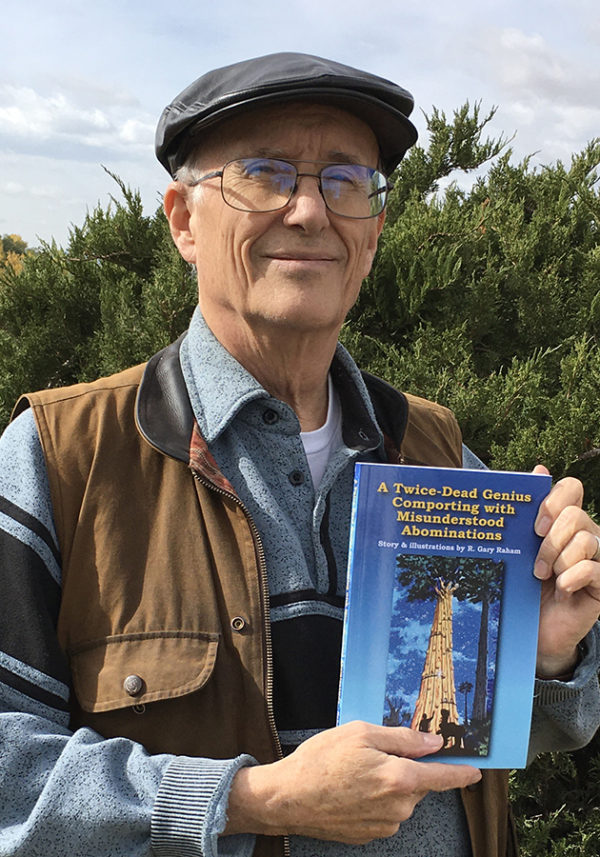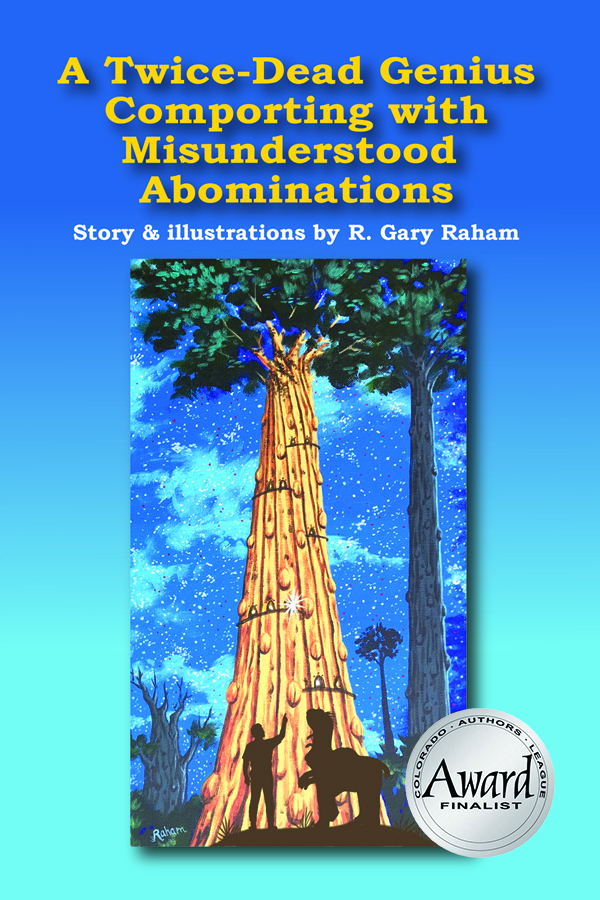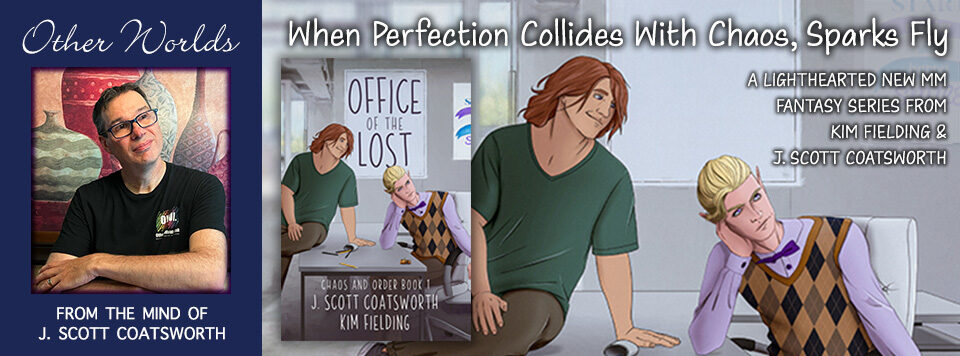
Welcome to my weekly Author Spotlight. I’ve asked a bunch of my author friends to answer a set of interview questions, and to share their latest work.
Today: R. Gary Raham writes both science fact and science fiction, and is a firm believer that the latter often excites a new generation of scientists to discover more of the former. Armed with degrees in biology from the University of Michigan, Raham taught high school science before pursuing careers in writing, illustration, and design. Raham has won numerous awards for his books, articles, and artwork. A Twice-Dead Genius Comporting with Misunderstood Abominations represents a fusion of his skills capable of making a reader laugh and think simultaneously with no known deleterious effects.
Raham has also written science titles for Chelsea House, Discovery Channel Books, Marshall-Cavendish, and Teacher Ideas Press. Many of his award-winning science articles for both children and adults are featured in Confessions of a Time Traveler (Penstemon, 2015), a finalist in the Colorado Authors’ League Awards.
Thanks so much, Gary, for joining me!
J. Scott Coatsworth: When did you know you wanted to write, and when did you discover that you were good at it?
R. Gary Raham: I loved telling stories at an early age. As part of the first television generation, I devoured “cowboy shows” on TV. Learning to write in elementary school, I drew cowboy hats on my capital letters. At home I drew and wrote my own comic book stories, flailing my arms when I created something I particularly liked. (I learned much later that that behavior might put me somewhere on the autism spectrum, but my parents didn’t seem concerned.). Teachers praised my writing, so I was motivated to continue—although one well-meaning English Teacher in high school thought concentrating on science fiction was a mistake. I didn’t. Science fiction fed my wonder lust.
JSC: How long on average does it take you to write a book?
RGR: It tends to take me a year to write a fiction book. I like to write for a couple of hours in the morning when I’m fresh. I circulate the chapters through my writing group which meets once every other week. Some members are great copy editors; others are better at seeing plot or character problems. A writer needs both kinds of input. I tend to edit as I go a lot, but like to let a segment “rest” for a day or two between editing sessions. I’ve also written nonfiction science books for hire with set deadlines—say 40,000 words in three months. For that kind of project, I figure out how many words I need to write per day to stay on schedule.
JSC: Why did you choose to write in your particular field or genre? If you write more than one, how do you balance them?
RGR: Writers like Isaac Asimov and Ray Bradbury first punched my “sense of wonder buttons.” I remember being intrigued by Asimov’s Foundation Trilogy and the idea that future history could be designed or imagineered to be better than it might otherwise be. Of course, Hari Seldon, the Psychohistorian protagonist in the series, found that all plans “gang aft agley” at some point. I also enjoy writing and explaining biology, paleontology, and ecology in a way that brings out the personal stories and excitement of scientists who work to unravel nature’s secrets. Science fact often inspires science fiction—and vice versa.
JSC: What was the hardest part of writing this book?
RGR: A Twice-Dead Genius Comporting with Misunderstood Abominations is my third SF novel. My first novel, A Singular Prophecy, took me nearly a decade to complete—partly because I was still working full time as a graphic artist, partly because it was a complex learning experience, partly because “life happens,” as everyone knows. My second book, A Once-Dead Genius in the Kennel of Master Morticue Ambergrand, wrote itself relatively quickly (a year). I knew early on that I had something good going on and I knew where I wanted to go with it. A Twice-Dead Genius started out as a sequel to A Once-Dead Genius, but early on I realized that I could weave characters from my first book into the tale. That process took more effort than I expected and I got much farther into the book before I had that “Eureka moment” where I realized I knew what the ending should be. I tend to write my fiction by the “seat of the pants” method and my non-fiction by developing an overarching outline. I love the surprises of the pants method, but it can cause angst until your subconscious kicks in with narrative solutions. So, I eventually ended up with a trilogy, but the preferred reading order is: Once-Dead Genius, A Singular Prophecy, and A Twice-Dead Genius.
JSC: Who did your cover, and what was the design process like?
RGR: I illustrate my own covers, an unusual state of affairs, but illustration is another of my passions, and I have spent at least four decades learning the craft of graphic design. I find it exciting and gratifying to create images that bring my imagined worlds alive. I only created a cover for A Once-Dead Genius, but realized that illustrations within A Twice-Dead Genius would help clarify my character relationships and give readers a glimpse of my alien creatures. The first cover for A Singular Prophecy was a graphic treatment, but I created a new painting for it to help integrate the covers of my trilogy. All three covers have appeared in several art shows and patrons have purchased prints of them. I’m always proud when that happens.
JSC: Were you a voracious reader as a child?
RGR: I was. My very first book purchase was an “ACE Double Novel” about the age of ten or so. “Men on the Moon” edited by Donald A. Wollheim was one side of the book and “City on the Moon” by Murray Leinster graced the other side. I also enjoyed reading about evolution, natural history, astronomy and other sciences. To this day I read about 35-40 books per year (about half fiction) and dozens—or even hundreds—of articles, usually related to articles I’m writing or to a current novel or short story in progress. When writing fiction, I like to read non-fiction that’s sort of related in some way to the ideas I’m exploring. I find that synergies develop that help me think of plot twists or provide bits of background information that characters can use to expand their depth and credibility.
JSC: What qualities do you and your characters share? How much are you like them, or how different are they from you?
RGR: I think most writers pattern their characters partly after themselves and partly after other people they have known. I’m no exception. Many of my protagonists tend to have some nerdy features that reflect my own preoccupations with the how and whys of things. The once and twice-dead genius, for example, could be some distortion of me who is smarter and much cleverer. I’ve also used my wife’s more assertive and fun-loving personality to embellish some characters. I always find it a little hard to get my characters into serious trouble—which is something I like to personally avoid as well—so I work a little harder to create fallible or downright despicable characters to help make trouble happen.
JSC: Would you visit the future or the past, and why?
RGR: Absolutely! I would roam both the past and future and somehow learn to “grok” the complexity of the space-time continuum. The concept of deep time and endless space has long fascinated me. Touching a fossil or ancient human artifact often provides a tangible conduit to the deep past. It inspires me to try and recreate some distant time in a painting or with a story. Perhaps Asimov’s Foundation trilogy was one impetus or perhaps hearing my mother’s stories of family history. (She came to America as a child on the Lusitania!) It’s hard to know. For a favorite science writer of mine, Loren Eiseley, it was the experience as a child of seeing Haley’s comet with his father. He wrote, “At four I had been fixed with the compulsive vertigo of vast distance and more endless time.” I’ve long felt that same compulsive vertigo.
JSC: How does the world end?
RGR: It will end by accident, apathy, or terminal combustion—or some combination thereof. Catastrophe could arrive unexpectedly like the asteroid that hit the Earth 66 million years ago and ended the dinosaur’s long reign. It could also end by human agency if we fail to understand our intimate connections to the rest of nature and make some fatal errors in judgement. Or, if the human race persists or evolves into some new species, the world might simply be consumed a few billion years from now when our star expands into a red giant and incinerates our unique planetary/biological experiment.
JSC: What are you working on now, and what’s coming out next? Tell us about it!
RGR: I’ve enjoyed living in the future world I created in the Dead Genius books. I wondered what happened to the people and aliens I left behind in my last tale. So, I began writing what I thought were a series of short stories about the humans and aliens who decided to stay Earthbound rather than gallivant off into the cosmos. My writers’ group told me I was writing another novel, and I believe they are right. I’m tentatively calling it The Chronicles of Gaia or perhaps The Citadel—I haven’t quite decided yet. It shares themes with my first books. Foremost among those themes is that we belong to a living tapestry of life 4 billion years in the making that we ignore at our own peril. I also truly believe that diversity, inclusion, and cooperation are keys to not only human survival, but the survival of the planet as well. I’m probably three quarters done with the text and have been working on a new cover painting! I’m hoping 2023 may be its year to appear.

And now for Gary’s book: A Twice-Dead Genius Comporting with Misunderstood Abominations:
Rudyard Albert Goldstein, inventor of the Biomic Network Algorithm, made peace with death in the 22nd century. But an idiot doctor hijacked his mind, placing it in the care of Nessie, an impish AI guardian. Then, he died again, nearly a million years later, merged with a worm-a-pede alien male sated after completing his conjugal obligations. They expired peacefully on a cliff top, pondering the nature of existence—and the promise of abominable liaisons.
Two deaths should be quite sufficient for any genius to endure.
Somehow, though, Nessie resurrected him from oblivion. His descendants needed him again. New hostile aliens roamed the Earth—along with a mysterious immortal hybrid with powers that rivaled those of Nessie. Was the healthy young body Nessie had prepared for him, along with the prospect of meeting a maker of universes, enough of a bribe to risk dying a third time?
Apparently so.
Readers of Raham’s A Singular Prophecy (Biostration, 2011), and A Once-Dead Genius in the Kennel of Master Morticue Ambergrand (Penstemon Publications, 2018) will reconnect with old friends (both human and alien). But even those new to the author’s quirky sense of humor will enjoy this third adventure that spans the breadth of time and space.
Get it On Amazon
Excerpt
Rudy couldn’t see a damn thing. He couldn’t hear, taste, smell or touch a damn thing for that matter. He felt like a disembodied spirit floating in a vacuum.
“That’s about right,” said a feminine voice with a vaguely foreign lilt that reminded Rudy of his second wife, Roxie—that teacher with a wealth of evocative bedroom lesson plans. But it wasn’t. It was a voice he should remember…
“Excuse me?” Rudy tried to open his eyes—with about as much success as he used to have removing the lids on Tupperware containers. “Who the hell are you?” A memory floated just at the edge of recovery, seemingly flicking like the tail of an angry cat.
“You know me, Rudy. I hope you remember me. Hope is hard for an AI to come by, you know. You helped give that to me over the millennia we worked together.”
“Nessie!” The name burst into his awareness—a memory bomb with loads of shrapnel. “Aka Mnemosyne—named after the Greek goddess of memory. Neh mos o nee.” His tongue always tripped over that name, so he called her Nessie. “You brought me back from the dead,” Rudy muttered.
“This will make the second time,” said Nessie, “but who’s counting?” Rudy’s eyes felt like they popped open. He connected the voice to an image: an attractive, pony-tailed young woman sat across from him. She sat on a deck chair—one that belonged to his first wife, Myra, back in the day. He appeared to be at the old cabin near Red Feather Lake. Man, was that a long time ago.
“Well over a million years ago,” Nessie said, just before taking a sip of coffee. “Don’t let your drink get cold—metaphorically speaking, that is.”
Rudy looked to his left. A cup of java sat there on a glass-topped end table, steaming like mist off a miniature lake in this virtual reality she had conjured many times before. She can read my thoughts. Of course she can. She’s a precocious artificial intelligence and I’m her charge—her responsibility. Except, I’m supposed to be really dead this time…along with Master Morticue Ambergrand.
“It was such a nice death, too,” observed Nessie. “The stars shone beautifully that night on the cliff. You and that nice worm-a-pede academic alien had a lot in common after all.” Nessie smiled that infuriatingly Mona Lisa-esque smile he now remembered clearly.
Rudy snorted. “Morticue and his kind made pets of humans. Just because he was three times bigger than a human and knew how to fall through a stargate to Earth didn’t make him King of the Hill.”
“Hubris nearly brought the downfall of your species before the asteroid strike completed the job, as I recall.” Nessie took another sip of coffee. “You biological metazoans do seem to get rather full of yourselves.”
“Unlike quantum dot computers with delusions of purpose?” Rudy winked at Nessie and took a sip of his own coffee. It tasted like his favorite dark roast, of course. Nessie wouldn’t forget a detail like that.
“Touché, Rudy.”
“So why am I here? Again.” Rudy had never been much good at small talk—not as a kid, not as an arrogant young researcher in Bioinformatics, not as a crusty old scientist with a reputation for genius he probably didn’t deserve. Apparently not as a computer simulation either.
“I have a problem. I need your help.” Nessie leaned toward him “And, frankly, I missed your company,” she said.
Did she really just bat her eyelashes? Rudy took a deep breath. Existence—and companionship—was habit-forming, it seemed.
Rudy leaned toward Nessie. “What kind of problem? Does it involve Morticue’s species—the Jadderbadians? What about my human descendants?” Rudy thought about Twill and Jeeta and the dark-skinned, long-limbed tribe of post humans that evolved after the asteroid strike that had destroyed his own civilization.
“Everyone’s impacted. Twill and Jeeta’s great grandchildren, the Jadderbadian Confederation—even the Jadaman settlements—where humans and Jadderbadians live as equals. Many futures hang in the balance.” Nessie placed her coffee cup on the table beside her.
She took a long enough pause that Rudy jumped in, although he felt shell-shocked. Twill and Jeeta’s great grandchildren? Jadderbadian Confederation? Jadaman settlements? “What’s going on? Another asteroid strike? Solar flares? Climate change? Wars? Did that post-Martian-human cyborg Pi come back? Invasion from space…?”
“Bingo!” Nessie interrupted with a verbal flourish. “I believe Bingo is a quaint old game humans played once,” she added parenthetically. “I understand they yelled the name of the game when they scored a linear sequence of letter matches.”
“An invasion of different space aliens?” Rudy ignored the Bingo digression and spread his arms in an exaggerated shrug.
“That’s pretty much it. Except this invasion first occurred 67 million years ago—plus or minus a few tens of thousands of years.” Nessie smiled her quirky smile again. “These particular aliens certainly don’t consider humans to be charming pets. In fact, I have reason to believe that they have genocide in mind.”
Rudy raised his eyebrows. “You’ve got to be kidding. Sixty-seven million years ago any visiting aliens would have been tripping over dinosaurs—or vice versa. Besides, they would have been destroyed by the same asteroid that pelted Earth and wiped out the dinosaurs at about that same time.”
“Or not. We survived the most recent Australian asteroid strike, as you recall. And I would never kid you, Rudy. Besides,” she added, “my sense of humor is still a work in progress. You know that.”
Rudy laughed. “Your sense of humor was in fine shape the last time I checked—though who knows how many lifetimes ago that was.”
Rudy sat back in his deck chair and sighed. Here we go again.
